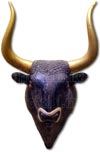The Archaeological Museum of Heraklion is one of the most important European museums. It is located in the centre of Heraklion city. Its construction began in the early 20th century and completed in 1940. During the Venetian rule, here was the Catholic monastery of St. Francis, the richest monastery on Crete, which was destroyed by an earthquake in 1856.
At the museum's ground floor there were 13 rooms open to the public. On the first floor, pieces of original paintings from the Palace of Knossos are exposed. All exhibits come exclusively from archaeological sites in Crete. Their exhibition is based on chronological order of periods.
Starting the tour at the Museum, visitors will see the evolution of pottery from the Neolithic Age (5000 - 2500 BC) until the Postpalatial period (2000 - 1700 BC), will admire the, inspired by the natural world, Kamares pottery (2000 - 1700 BC). Some of the vases were classed as "egg -casing" due to the thinness of their sides and can be compared with modern porcelain dinnerware.
A unique exhibit is the famous disk of Phaistos with signs of hieroglyphic writing and ideograms. Unfortunately, the content of the disk is still unknown.
The goddesses of the Minoan people, known as "snake goddesses", are standing impressive, holding snakes in their hands and wearing the traditional Minoan costume.
A remarkable sculpture example is the bull-head, made by Steatite and the "bull-rider", made by ivory.

Remarkable are the gold jewelry, the mirrors with ivory handles, the tweezers for the eyebrows, the ivory combs and the swords with golden handles, all of Minoan necropolis findings.
One of the showcases of the museum is decorated with "bees", found in Malia, a beautiful ornament depicting two bees carrying a drop of honey in the honeycomb.
There are everywhere double axes, the "holy" symbol of the Minoan period, while sarcophagus, which are made primarily of clay, causing admiration with their size and their simplicity.
Finally, seeing the original pieces of the murals from the Palace of Knossos, you can discern the mood of the Minoans for life and for worship of nature. The colors, which were used, were based on the nature and are kept unchanged up today.